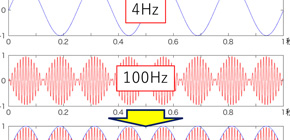
Brain waves characteristic of epileptic seizures detected, a world first
Will lead to the clarification of clinical condition, diagnostic accuracy, and improvement of medical treatment of the disorder
A group of researchers led by Dr. KISHIMA Haruhiko (Lecturer, Division of Medical Sciences Neurosurgery, Graduate School of Medicine, Osaka University) found that coupling in intracranial electroencephalography (iEEG) was more strongly shown during a seizure than in the resting state.
Dr. Kishima's group focused on the fact that coupling between two different brain waves played an important role in information processing in the brain while proceeding with their research.
During epilepsy surgery, it’s possible to make a correct diagnosis using an EEG test in which electrodes are placed on the brain's surface or a region deep in the brain. For example, rhythmic waves (big waves with low frequency) during the ictal state, as well as high-frequency waves such as γ waves (25-150 Hz) and ultra-low-frequency waves (0.5 Hz or less) -- obtained only by scalp electroencephalography (EEG) -- are helpful in making an epilepsy diagnosis. This group showed that it was possible to capture epileptic seizures more correctly than ever by focusing on the relationship between the low-frequency phase and high-frequency amplitude.
In this study, using data of brain waves of refractory temporal lobe epilepsy patients recorded for the purpose of treatment, the strength of coupling was calculated and compared between the ictal and interictal states. As a result, it was found that the high-accuracy measurements of coupling using intracranial electrodes placed on the surface of the brain of epileptic patients had enabled the correct detection of seizures.
It was also found that coupling during the seizure was stronger than that during the resting state. This trend was clearly observed in the combination of the phase of the lower-frequency β band (13–25 Hz) and the amplitude of the high γ band (80–150 Hz) in particular. Based on this unique increase during the ictal state, this group detected seizures at a high sensitivity and specificity by using the method for detecting seizures in long-term EEG monitoring.
This group succeeded in detecting epileptic seizures with great accuracy by using coupling, a world first. From this, it is possible to accurately detect the time of a seizure during a long-term electroencephalogram recording in the hospital and inform hospital staff of the seizure. Furthermore, it will lead to the development of methods for predicting patients of the seizure in their daily lives through the use of an implanted device. Coupling is thought to be closely related to the clinical condition of epilepsy, so this group’s achievement will be used for the clarification of clinical condition, diagnosis, and better care of epilepsy.
Abstract
Seizure detection using intracranial electroencephalography (iEEG) contributes to improved treatment of patients with refractory epilepsy. For that purpose, a feature of iEEG to characterize the ictal state with high specificity and sensitivity is necessary. We evaluated the use of phase–amplitude coupling (PAC) of iEEG signals over a period of 24 h to detect the ictal and interictal states. PAC was estimated by using a synchronisation index (SI) for iEEG signals from seven patients with refractory temporal lobe epilepsy. iEEG signals of the ictal state was characterised by a strong PAC between the phase of β and the amplitude of high γ. Furthermore, using SI values, the ictal state was successfully detected with significantly higher accuracy than by using the amplitude of high γ alone. In conclusion, PAC accurately distinguished the ictal state from the interictal state.

Figure 1

Figure 2
To learn more about this research, please view the full research report entitled “ Detection of Epileptic Seizures Using Phase–Amplitude Coupling in Intracranial Electroencephalography ” at this page of the Scientific Reports website.
Related Link

